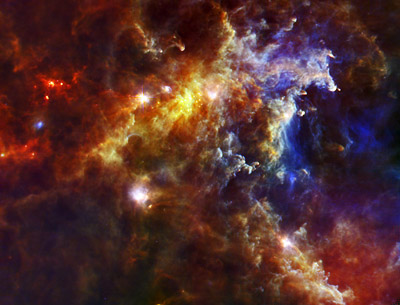MURDER, POLITICS, AND THE END OF THE JAZZ AGE
by Michael Wolraich
Last week Nova aired a program on the evolution of telescopes. Galileo and on through the ages, changes bigger and better in fits and starts: refractors, reflectors mirrors growing bigger and bigger, to Hubble, and now: The Herschel Space Observatory Telescope, the first to use infra-red light source is hurling through space, able to measure the heat signatures of celestial bodies. Now it's possible to see beyond the bright bodies and clouds of cosmic gases into the heart of formation, to gather information about what came before. Pretty trippy stuff for those cosmologists with constant and nagging questions about the beginnings of it all.
Herschel was launched on May 14 with its companion Planck, which is able to cool its instruments to one degree above Absolute Zero, and record images of the coldest objects in space. It can see and measure wavelengths not detectable by human eyes in three colors.

(This is the first image generated by Herschel, after which they re-calibrated its imaging.)
Three-colour far-infrared image of M51, the 'whirlpool galaxy.' Glowing light from clouds of dust and gas around and between the stars is visible clearly. These clouds are a reservoir of raw material for ongoing star formation in this galaxy. Credit: ESA and the PACS Consortium

12 April 2010
Herschel's latest image reveals the formation of previously unseen large stars, each one up to ten times the mass of our Sun. These are the stars that will influence where and how the next generation of stars are formed. The image is a new release of 'OSHI', ESA's Online Showcase of Herschel Images.
The Rosette Nebula resides some 5,000 light years from Earth and is associated with a larger cloud that contains enough dust and gas to make the equivalent of 10,000 Sun-like stars. The Herschel image shows half of the nebula and most of the Rosette cloud. The massive stars powering the nebula lie to the right of the image but are invisible at these wavelengths. Each colour represents a different temperature of dust, from -263ºC (only 10ºC above absolute zero) in the red emission to -233ºC in the blue.

In this colour-coded Spitzer image of the DR 21 star-forming region, the green reveals the emission from large molecules set aglow by the newly formed stars. The blue and red boxes show the area that HIFI has already surveyed for ionized carbon, a key ingredient of the molecular cloud material. Credit: ESA and the HIFI Consortium
This one was taken by Hubble Telescope:
 The image shows a rich tapestry of 7,500 galaxies in one tiny portion of all the available fields...
The image shows a rich tapestry of 7,500 galaxies in one tiny portion of all the available fields...
Some perspective, yes? Telescopes have now mapped over 100 billion Galaxies, each containing over 100 billion stars. At the beginning ot the 20th Century, we were quite sure that the Milky Way (our home Galaxy, was the total extent of the Universe..
Sir Frederick William Herschel (1738-1822), for whom the infrared space telescope was named, was a German-born British amateur astronomer who became famous for his discovery of the planet Uranus; he also discovered infrared radiation, and made many other astronomical discoveries .
This is a link to the Herschel Observatory site.